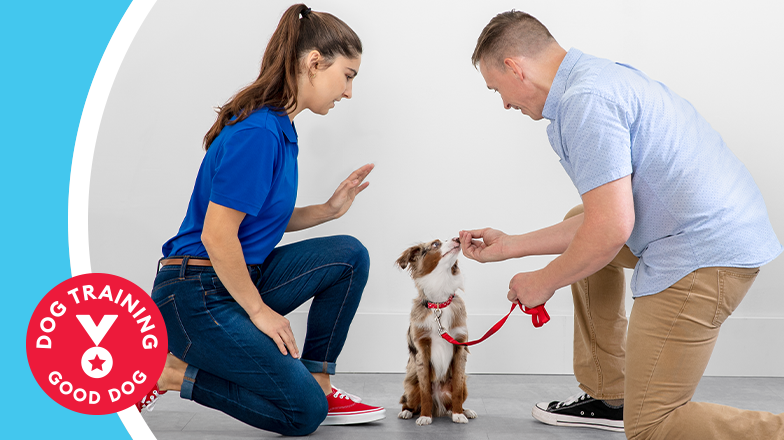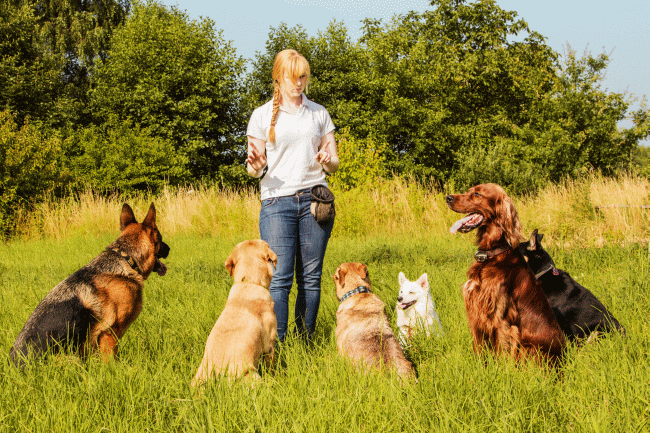Looking for Dog Training Near Me? Discover Local Trainers Who Can Help
Looking for Dog Training Near Me? Discover Local Trainers Who Can Help
Blog Article
Beginner's Overview to Successful Canine Training in your home
Successfully educating a dog at home calls for a nuanced understanding of canine actions and efficient communication approaches. Establishing clear training goals, making use of premium rewards, and keeping consistency across family participants are essential elements. Incorporating training right into day-to-day routines can improve both engagement and retention.
Understanding Dog Actions
Comprehending canine behavior is important for reliable training and cultivating a harmonious partnership in between humans and their canine friends - Puppy Training. Dogs communicate largely through body movement, vocalizations, and faces, making it critical for proprietors to analyze these signals properly. Identifying behaviors such as tail wagging, grumbling, or trembling can provide insights into a pet dog's emotional state and intentions
Additionally, understanding the all-natural impulses of canines, such as their pack mindset, helps owners establish management duties within the household. This is vital for developing an organized environment where canines feel safe and secure and are more responsive to training. Pet dogs are likewise influenced by their socializing experiences; early direct exposure to various atmospheres, people, and other pets can dramatically shape their actions later on in life.
Common behavior issues, such as hostility, stress and anxiety, or too much barking, usually come from misunderstandings or unmet demands. Observing and resolving these problems promptly can stop escalation and guarantee a favorable training experience. By promoting a deep understanding of canine habits, owners can tailor their training methods to suit their canine friends, inevitably leading to a contented and well-behaved pet.

Essential Educating Tools
A fully equipped training room can significantly boost the performance of canine training in the house. Crucial training tools make certain that both the dog and the fitness instructor can take part in efficient sessions that promote learning and bonding.

Investing in a sturdy leash and a comfy, well-fitting collar or harness is essential for security and control. These devices assist establish limits and ensure the canine continues to be secure throughout training. In addition, an assigned training location, cost-free from diversions, aids focus for both the fitness instructor and the pet.
Educating aids such as training pads, cones, or dexterity equipment can also improve the experience by introducing variety and obstacles. Last but not least, having a note pad or digital app for tracking progression can be very useful, allowing you to keep in mind successes and areas for improvement. Using these important devices will certainly produce a favorable training environment and lay the foundation for effective discovering.
Developing a Training Routine
Developing a regular training regimen is vital for reliable pet dog training in your home. A well-structured regular not just assists in reinforcing preferred actions but likewise gives your dog with a complacency and predictability. To create a reliable training regular, begin by determining certain training objectives, such as basic commands, chain strolling, or housebreaking.
Choose a marked time daily for training sessions, preferably when your pet is receptive and alert. Sessions needs to be brief, about 5 to 15 mins, to preserve focus and prevent exhaustion. Uniformity in timing and setting will improve your dog's understanding experience.
Incorporate training into daily tasks to reinforce skills. Technique commands throughout walks or mealtime, which integrates discovering into natural regimens. In addition, continue to be flexible and adjust the regular as required, fitting your canine's energy degrees and state of mind.
Positive Support Methods

When implementing positive support, it is important to pick incentives that are encouraging for your pet. High-value treats, such as little pieces of poultry or cheese, can be specifically efficient throughout training sessions. Furthermore, differing the rewards can keep your pet dog's rate of interest and enthusiasm.
Beginning with simple commands, like "rest" or "stay," and gradually progress to much more complex jobs. Uniformity is key; ensure that all member of the family make use of the same commands and incentive systems to avoid confusion.
Furthermore, it is important to remain individual and avoid irritation. Pet dogs, like human beings, discover at their own speed. By promoting a supportive training atmosphere via positive support, you can boost your pet's discovering experience while strengthening the bond between you and your fuzzy companion, preparing for effective training end results.
Typical Training Obstacles
While educating a pet in your home can be a fulfilling experience, it often comes with a collection of usual obstacles that can evaluate both perseverance and consistency. One common concern is diversion. Pet dogs may end up being quickly averted by sounds, movements, or perhaps scents in their setting, making it hard to maintain their focus Continue during training sessions.
One more obstacle is variance in commands and support. If member of the family use various cues or rewards, it can hinder and confuse the dog progress. Establishing a unified approach is essential for efficient interaction.
In addition, canines can experience aggravation or stress, specifically if they do not comprehend what is anticipated of them. This can cause unwanted actions, such as eating or barking.
Finally, the timing of reinforcement is crucial. Delayed rewards can decrease the efficiency of favorable support, as pet dogs might fall short to attach the behavior with the incentive.
Conquering these obstacles needs commitment, clear communication, and an organized training plan - Puppy Training. Recognizing and resolving these usual obstacles will lead the way for a more effective and enjoyable training experience in your home
Final Thought
In conclusion, successful canine training at home demands a comprehensive understanding of canine behavior and efficient communication find out here methods. By developing clear training objectives and utilizing top quality deals with along with positive reinforcement, the training process comes to be extra gratifying for both the fitness instructor and the dog.
Developing a regular training routine is essential for effective pet dog training at home.Favorable reinforcement strategies are essential to efficient canine training, advertising desired habits with benefits rather than penalty. By promoting a helpful training environment with positive reinforcement, you can boost your pet's understanding experience while strengthening the bond in between you and your furry buddy, laying the foundation for successful training results.
In verdict, effective pet training at home demands a comprehensive understanding of canine behavior and efficient interaction strategies. By developing clear training objectives and using top quality treats along with positive support, the training process ends up being more satisfying for both the dog and the instructor.
Report this page